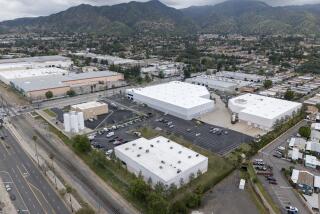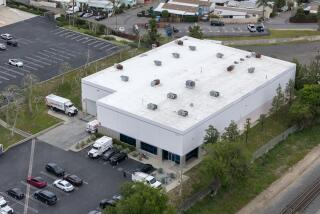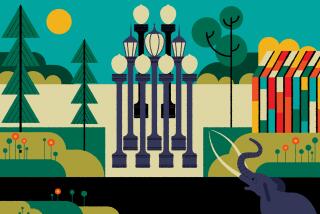Mobs Spared Most of City’s Cultural Centers During Rampage : Violence: Officials are surprised that treasured museums, theaters and other landmarks fared so well during riots.
During the first night of rioting, the 200 people who stormed downtown headed up Los Angeles Street past the Federal Building. The mood was raucous as the rioters lit fires and broke windows and, it seemed, nothing was safe from their wrath.
But when several men with baseball bats and lighted newspapers headed toward the Children’s Museum, other demonstrators called them off. “Leave that alone,” one woman pleaded. “That’s a museum.” And the men heeded her advice.
The next afternoon, Mark Rodriguez stood on the roof of the Los Angeles County Museum of Natural History and watched a mob of looters attack a mini-mart just one and a half blocks away from Exposition Park. Thinking it was only a matter of time before his museum would be struck, Rodriguez, the chief deputy director, frantically began plotting which artifacts he should try to save.
But the mob never arrived.
“The (looters’) attention was focused on something they could use readily--shoes, food, electronic equipment, something to drink,” Rodriguez said Monday, reflecting on why the museum was spared. But he and others in the cultural community believe there were other reasons as well.
“They were protesting that the authority in this city had neglected them and their families,” he said. “In those early hours of the rioting, I think the consciousness was that the museum didn’t represent authority. It represented something that they were trying to protect. And I think that’s what saved us.”
As city leaders assess riot-related damage, many have been struck by how well much of Los Angeles’ cultural infrastructure has fared. There were terrible losses--the Aquarian Bookshop, the nation’s oldest black-owned bookstore, was burned to the ground. Of the city’s 63 public library branches, two that were housed in mini-malls in South-Central Los Angeles were destroyed by fire, causing $750,000 in damage.
But preliminary tallies indicate that many of the city’s treasured museums, theaters and other landmarks can be counted among the survivors of the most violent and costly riots in the nation’s history.
“My sense overall is there was very little physical damage to the arts infrastructure. Generally, people pretty much respected the cultural institutions,” said Adolfo Nodal, general manager of the city’s Department of Cultural Affairs, who noted that the three community arts centers located in South-Central Los Angeles were completely undamaged.
“Cultural institutions didn’t seem to be a priority” for the looters, said Pamela Jenkinson, spokeswoman for the Los Angeles County Museum of Art, which was unscathed. The museum sustained only minor damage at a storage warehouse in Central Los Angeles.
Also spared, Nodal said, were most of the city’s murals; the single known casualty Monday was an Olympic-themed mural on the side of a mini-mall at 40th and Vermont.
The artists’ community on Degnan Boulevard near Leimert Park was not looted. The Museum in Black, a collection of African art and black memorabilia, was untouched. The Simon Wiesenthal Center on Pico Boulevard and La Cienega was unharmed, as was the Japanese American National Museum in Little Tokyo.
The Los Angeles Historic Theater Foundation reported only one theater lost, despite many close calls--the Pickfair Theater on Pico Boulevard. A fire next door to the prized Palace Theatre on Broadway stopped short of engulfing it, said John E. Miller, the theater foundation president. Even Mann’s Chinese Theater and the El Capitan, located on a stretch of Hollywood Boulevard that was ravaged, escaped unscathed.
“You’d think they’d be a likely target,” Miller said. “But I think (the looters) were out to steal, and there’s not much to steal in a theater. Everything is nailed down but the snack bar.”
On Monday, as the city struggled to return to normal, cultural officials and behavioral experts said that--in addition to luck--probably a variety of factors allowed cultural institutions to survive.
In recent days, Cheryl Armon, a professor of human development at Antioch University Los Angeles, has interviewed a handful of looters as background for a possible study of what motivated them. She cautions that the looters were not all the same--some, such as those who marched downtown, were trying to make a political statement; many more, she said, were merely seeking material gain.
But neither of these groups, Armon said, were likely to prey on cultural institutions.
“The more politicized groups that were specifically targeting certain areas, it would make sense they were the same people who might save a museum,” said Armon, who studies aesthetic understanding and moral development. “Others, who were targeting stores where they could get the best stuff and wouldn’t get caught, might not target a museum because its assets weren’t liquid--they couldn’t sell it, eat it or wear it.”
While both motives may have been at work, Armon speculated that economics probably far outweighed politics in the minds of those on the rampage.
“The folks I have talked to who did some looting have never been to that museum once,” she said of the California Museum of Science and Industry, one of the museums in Exposition Park that was undamaged. “I can guarantee it.”
Jeffrey N. Rudolph, the executive director of the science museum, agreed that a combination of factors kept his institution safe. But he said in addition to security and luck, he hopes that community pride in the museum played a role.
“I do believe there is some sense that these institutions do serve people,” he said Monday. “It’s a combination of that and our department of public safety. And the National Guard being here didn’t hurt.”
Since late Thursday, the National Guard has used Exposition Park as a staging area.
Across the street from the Children’s Museum, vandals were methodical enough to yank up a bed of flowers that usually surrounds the marble sign in front of the federal courthouse. And yet, reported a gratified Dan Niebrugge, the museum’s managing director, his institution was untouched.
Did he believe that the museum was spared because of its role in the community? “I would certainly hope no one would want to tee off against an institution that is child-serving. We have a grudge towards no one,” he said. “Far be it from me to speculate, but I would certainly hope so.”
Nodal, the city cultural affairs manager, said he believes the real cultural cost of the riots is yet to be measured: Lost revenue, combined with a likely dearth of funding as the city tries to rebuild, he said, will challenge the arts community.
“And of course there was a lot of emotional and psychological damage that needs to be repaired.”
Bob Reagan, spokesman for the Los Angeles Public Library, agreed. One of the most chilling things about the riots for him, he said, was the date they began.
“This all started on the sixth anniversary of the Central Library fire,” he said, referring to the 1986 fire that destroyed 375,000 books. “April 29 is no longer the anniversary of the library fire. Now it’s the anniversary of the riot.”
Following is a partial list of museums that plan to resume their normal schedules beginning today:
California Museum of Science and Industry, 700 State Drive, (213) 744-7400. Open daily 10 a.m. to 5 p.m. Admission: Free.
The Children’s Museum, 310 N. Main, (213) 687-8801. Open to the public Wednesday and Thursday from 2 p.m. to 4 p.m. and weekends from 10 a.m. to 5 p.m. Admission: $5 for adults and children.
Los Angeles County Museum of Art, 5905 Wilshire Blvd., (213) 857-6522. Open Tuesday through Thursday, 10 a.m. to 5 p.m., Friday 10 a.m. to 9 p.m. and Saturday and Sunday 11 a.m. to 6 p.m. Admission: $5 for adults, $3.50 for students and senior citizens, $1 for children ages 6 to 17 and free for children 5 and younger. Free on the second Tuesday of each month.
Los Angeles County Museum of Natural History in Exposition Park, (213) 744-3414. Open Tuesday through Sunday, 10 a.m. to 5 p.m. Admission: $5 for adults, $3.50 for students and seniors, $2 for children ages 5 to 12 and free for children 5 years old and younger. Free on Tuesdays.
Museum of the Southwest, 234 Museum Drive, (213) 221-2164. Open Tuesday through Sunday, 11 a.m. to 5 p.m. Admission: $5 for adults, $3 for seniors and students, $2 for children ages 7 to 18 and free for children 6 and younger.
Museum of Contemporary Art, 250 S. Grand, (213) 626-6222. Open Tuesday through Sunday, 11 a.m. to 5 p.m. and until 8 p.m. on Thursday. Admission: $4 for adults, $2 for students and senior citizens.
Times staff writers George Ramos and Shauna Snow contributed to this article.
More to Read
Sign up for Essential California
The most important California stories and recommendations in your inbox every morning.
You may occasionally receive promotional content from the Los Angeles Times.










